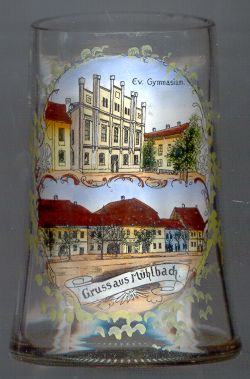

|
| ROMÂNIA | ROMANIA |
| județ Alba | Alba County |
Sebeș is situated on the Răul Sebeșul stream (Hungarian: Sebes, German: Mühlbach) near its mouth into the Mureșul (Maros, Mieresch) river, surrounded by the spectacular mountain region of southwestern Transilvania.
The origins of Sebeș go back to a foundation of German settlers (the so-called Transilvanian Saxons) who were called into the country by King Géza II of Hungary in the second half of the 12th century. These settlers were also granted important privileges and relative autonomy by András II in 1224. Sebeș (Mühlbach) was one of the so-called "Seven German towns of Transilvania" – together with Schäßburg (Sighișoara, Segesvár), Großschenk (Cincu, Nagysink), Reußmarkt (Miercurea Sibiului, Szerdahely), Reps (Rupea, Kőhalom), Leschkirch (Nocrich, Újegyház) and Broos (Orăștie, Szászváros) plus the main town, Hermannstadt (Sibiu, Nagyszeben) – that were granted the right to appoint there own leaders, their own clergy and judges, and operate markets and courts. The German name "Malenbach" was first mentioned in a document of 1245, the name "Sebus" appeared first in 1301. The oldest document characterising the place as a civitas, a town, dates from 1341.
 For centuries, the town was renowned for its crafts and trade.
During the 15th and 16th century the town was besieged and occupied several times by the Turks.
During one of heir raids, in 1438, a young student from the grammar school was among those captured by the Turks. Twenty years later
he managed to escape and subsequently wrote the first factual description of Turkey
("Tractatus de moribus, conditionibus et nequitia Turcorum", published in Urach in 1481).
The book is also the oldest one published by an author from Transilvania. The author is only known as
Captivus Septemcastrensis, Frater Georgius de Ungaria, Frater Schebeschensis, or Rumeser Student. He concluded his
life as a Dominican monk in Rome where he died in 1502.
For centuries, the town was renowned for its crafts and trade.
During the 15th and 16th century the town was besieged and occupied several times by the Turks.
During one of heir raids, in 1438, a young student from the grammar school was among those captured by the Turks. Twenty years later
he managed to escape and subsequently wrote the first factual description of Turkey
("Tractatus de moribus, conditionibus et nequitia Turcorum", published in Urach in 1481).
The book is also the oldest one published by an author from Transilvania. The author is only known as
Captivus Septemcastrensis, Frater Georgius de Ungaria, Frater Schebeschensis, or Rumeser Student. He concluded his
life as a Dominican monk in Rome where he died in 1502.
In 1560/1561 Sebeș was the last of the Transilvanian towns to become Protestant. Until 1687 Transilvania had to pay tributes to the Ottoman Empire. After the victory of the Imperial troops over the Turks in 1698 at Ofen (Budapest), the area became part of the Habsburg countries.
After World War I, Sebeș became part of the Kingdom of Romania. After World War II the German-speaking population was depossessed and most of them left the country during the following decades. Today only about 1% of the population still speak German.
The upper part of the picture on glass no. 1557 [left] shows the
 Protestant
Protestant
Another glass in this collection shows a view of Mühlbach/Rio di Pusteria, South Tyrol, Italy.
![[scale]](lineal.jpg)